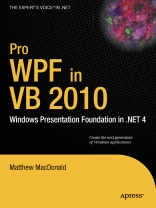Microsoft’s Windows Presentation Foundation (WPF) provides the foundation for building applications and high-quality user experiences for the Windows operating system. It blends the application user interface, documents, and media content, while exploiting the full power of your computer’s operating system.
Its functionality extends to the support for tablet PCs and other forms of input device, and provides a more modern imaging and printing pipeline, accessibility and user interface automation infrastructure, data-driven user interface and visualization, and integration points for weaving the application experience into the Windows shell.
This book shows you how WPF really works. It provides you with the no-nonsense, practical advice that you need in order to build high-quality WPF applications quickly and easily. Having built a firm foundation, it goes on to explore more advanced aspects of WPF and how they relate to the others elements of the .NET 4.0 platform and associated technologies such as Silverlight.
Tabela de Conteúdo
Introducing WPF.- XAML.- Layout.- Dependency Properties.- Routed Events.- Controls.- The Application.- Element Binding.- Commands.- Resources.- Styles and Behaviors.- Shapes, Brushes, and Transforms.- Geometries and Drawings.- Effects and Visuals.- Animation Basics.- Advanced Animation.- Control Templates.- Custom Elements.- Data Binding.- Formatting Bound Data.- Data Views.- Lists, Trees, and Grids.- Windows.- Pages and Navigation.- Menus, Toolbars, and Ribbons.- Sound and Video.- 3-D Drawing.- Documents.- Printing.- Interacting with Windows Forms.- Multithreading.- The Add-in Model.- Click Once Deployment.
Sobre o autor
Matthew Mac Donald is an author, educator, and MCSD developer who has a passion for emerging technologies. He isthe author of more than a dozen books about .NET programming. In a dimly-remembered past life, he studied English literature and theoretical physics.












